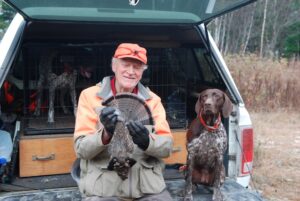Good Grouse Habitat

By Paul Fuller
We know that all living creatures need two items, shelter and food. It’s called habitat. Over the past few years, your columnist has written about the three phases of grouse food. Those three phases represent the food side of habitat. Now, let’s talk about the shelter side of habitat.
We’re going to explain shelter by following a young male grouse right after his brood (brothers and sisters) break up. Let’s call him Henry. This is not an attempt to anthropomorphize our Henry but just an easy way to keep track of his activities.
Henry’s natural instincts tell him that he needs to find about a 15- acre section of habitat that provides him with all the food and shelter he needs to take care of a harem of several hens. This habitat is usually what biologists refer to as a piece of land that is in early successional growth; or, early successional vegetation. Early successional growth can happen anywhere. It can happen in your front yard, in the prairies and in the grouse woods. In the grouse woods, it begins with logging a mature forest. A mature forest is typically of little use to most wild animals…except perhaps squirrels.
New Growth
After the mature forest has been harvested, perennials begin to appear. Henry is looking for that new perennial growth. In the Northeast, it’s often raspberry plants. In fact, large sections of raspberry plants. Grouse love the leaves of the raspberry. This early growth is also excellent for whitetail deer and rabbits. Next early growth are shrubs and vines. And, then you’ll see aspen beginning to appear. Aspen are a key ingredient in ruffed grouse food and shelter. For food, it’s the aspen bud which is high in nutrition. Also, the thick growth of early aspen provides excellent protection from aerial grouse predators…hawks and owls. Sandy soil is the best for aspen growth. Henry is going to settle down in an area with excellent aspen growth. His harem and their broods will do well with young aspen growth.
Your author’s favorite Northern Maine grouse cover is a thick aspen stand, perhaps ten years old, with an adjacent thicket of vines. Vines so thick it’s impossible to walk through them. If I send in one of the dogs, the grouse run to an outer edge and then flush. It would be impossible for them to flush in the midst of the vines. If I’m hunting that cover alone, even with a nice point, I rarely get a shot. The flush is too far out. If Susan is with me, one of us will stay with the dog and the other circle around to the far side of the vineyard. The far side of the vineyard usually permits a shot.
New Coverts
A great amount of grouse hunting fun is searching for new coverts. When we’re hunting the North Maine Woods, we usually spend one whole day just looking for new coverts. And, we always find at least one or two new areas to put down the dogs.
To quote an iconic New England outdoor writer, Frank Woolner: “birds are where you find them.” However, you’ll find them more often in a 10-15 year aspen cut. The aspen provide both food and shelter which is grouse habitat.
For more articles about hunting, fishing and the great outdoors, be sure to subscribe to the Northwoods Sporting Journal.

